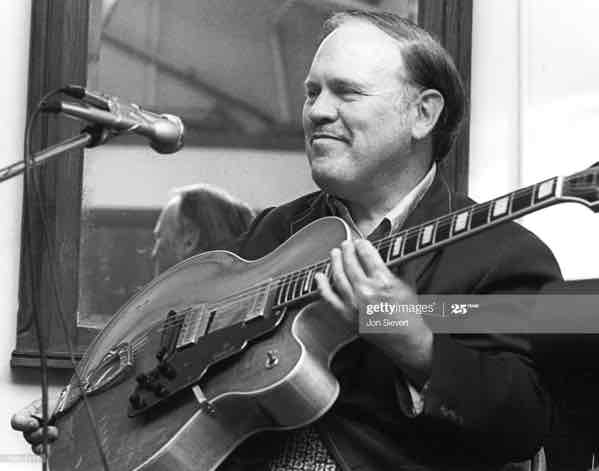
GEORGE BARNES
George Barnes was born July 17, 1921 in a Chicago suburb. He came from a family of professional musicians and his father, who was a guitarist taught him to play at age 9. George’s original chosen instrument was the piano, which he began playing at age 6 but, when the Barnes family lost their piano as well as their house in the depression all that was left was a Sears Roebuck Silvertone guitar with an action about an inch high. George worked hard at this instrument and by the age of 12 had joined the union. He had by this time heard the records of Bix Beiderbecke featuring Joe Venuti and knew that he wanted to be a jazz musician.
Although there were few guitarists around at that time who soloed, George never wanted to play rhythm – he wanted to play melody. He had heard many of the records of Django Reinhardt but never related to him because Django sounded foreign to him. George was mostly influenced by the horn and reedmen who he played with whilst growing up in Chicago. The single greatest influence was Jimmy Noone, the Chicago clarinetist, with whom George was playing when he was 16. Other influences were Benny Goodman and Louis Armstrong. During this time George also hung around with Lonnie Johnson who taught him how to play the blues. He claimed to have been playing electric guitar from 1931 when his brother built a pickup and amplifier for him. It is not clear who the first electric guitar player was but George must, surely, have been among the first.
At 14 he formed the George Barnes Quartet and two years later made his first records under his own name – I’m Forever Blowing Bubbles and I Can’t Believe That You’re In Love With Me for Okeh records. At 17 he joined the staff at NBC in Chicago and became the youngest conductor/arranger they ever had. Around this time he was recording with top black blues artists such as Big Bill Broonzy often being the only white player on the date. Hughes PanassiÈ once referred to George as “the great Negro blues guitarist from Chicago.” This was brought to an end in 1942, when George was drafted.
In 1951 George made the move to New York where he immediately got a contract at Decca to conduct, arrange, do backing vocals, his own albums and record dates (he said the only thing he didn’t do was sweep floors!). His first gig in NY was playing opposite Tal Farlow at the Embers. George also met Carl Kress in 1951, the start of a friendship that was to result in the formation of the critically acclaimed George Barnes/Carl Kress Duo in later years. They toured the world together and made some of the finest guitar duo recordings ever. Around this time George had the Guild Guitar Company build a unique guitar to his specifications partly arising out of his dissatisfaction with the way electric guitars were prone to feedback.
After Kress’ death in 1965 George’s next partner was to be Bucky Pizzarelli. Their 3 year partnership produced such fine albums as Guitars Pure And Honest before Bucky went on to form his own career. The next and probably the most famous of George’s associations was with cornet player Ruby Braff. Together with rhythm guitarist Wayne Wright and bass player Michael Moore they formed the George Barnes/Ruby Braff Quartet, which again toured the world and delighted audiences everywhere.
George had a unique technique in playing the guitar in that he held the pick between his thumb and middle finger, claiming that it gave him more control; played with mainly down strokes and when creating vibrato he did it across the fingerboard instead of in line with the fingerboard as most guitarists do. His sound was instantly recognizable and a joy to listen to.
Before his death in 1977, George Barnes’ final live performance with his Quartet was recorded and has just been released by mandolinist David Grisman’s Acoustic Disc label as Don’t Get Around Much Anymore. Recorded by engineer Larry Cumings, this disc captures Barnes’ spirit and vitality as one of the world’s finest guitar players ever.